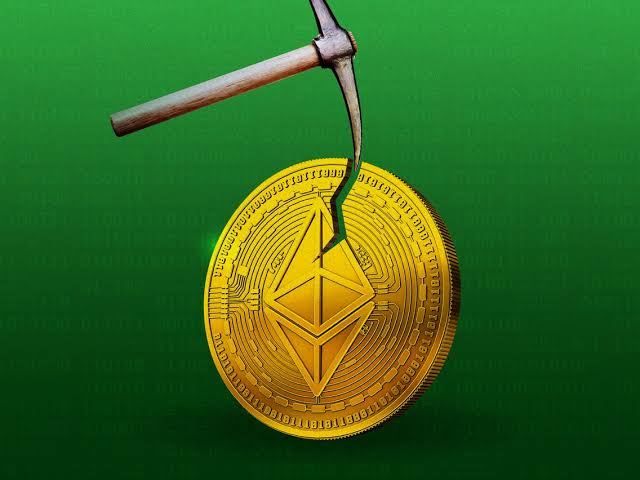The ability to mine cryptocurrencies through the solution of challenging mathematical puzzles and problems is one of their distinctive features. Similar to Bitcoin, mining on the Ethereum network allows you to produce new Ether tokens and receive Ether as payment for completing PoW (Proof of Work) tasks.
Ethereum Mining
Blockchains employ the mining procedure to verify and authenticate newly added transactions to their network. This procedure is connected to the consensus known as proof-of-work, or PoW. It assists in removing the potential for double spending and associated threats. A miner adds a block to the network and validates it on the blockchain by mining it successfully.
Step-by step process on how to mine Ethereum
Ethereum mining can be a capital-intensive process, depending on the level of difficulty and competition. The procedures listed below can be used to begin mining Ethereum:
Step 1:Create an Ethereum-based crypto wallet
You will need a cryptocurrency wallet that can store your mined Ethereum rewards once you finish. There are many alternatives available; a few of the well-liked ones are as follows:
Ledger S Nano, Exodus, .Mist, Trezor One and MetaMask
Step 2: select your mining equipment.
To mine ether, you’ll need a very strong computer system. Owing to fierce competition, a powerful system is essential. A low-powered, entry-level system will not mine quickly enough to turn a profit. Nevertheless, before purchasing hardware for cryptocurrency mining, there are a few considerations to make. The elements are:
a.Equipment expenses
Heavy initial investments are needed for cryptocurrency mining equipment. How profitable your Ether mining is will depend on how powerful and fast your system is. Choosing a GPU mining rig over a CPU-based one will yield superior results.
An application-specific integrated circuit (ASIC) miner is an additional option. They are specifically designed to mine Ethereum. You can mine cryptocurrency profitably thanks to their high performance. The Bitmain Antminer E9 is one instance of a system like this. It is regarded as the most potent Ethereum miner in the world.
b. cooling mechanism
You need to spend money on a cooling system since mining rigs operate nonstop. It can be included in the upfront expenses for setting up your mining rig. Having a strong and effective cooling system enables your rig to run at peak performance all day. To cut expenses, some miners even move their operations to colder areas.
cfast internet connectivity
Additional prerequisites include having a fast internet connection. Your operation will be more efficient and have a lower latency the faster it runs.
d.Legality
The governments of many nations are reevaluating their positions on the legality of cryptocurrency mining in light of the high electricity consumption and its effects on the environment. Before beginning any mining activities, be sure to check with the local authorities.
Step 3: Select a mining approach
Depending on your spending plan and investing style, you can select the mining strategy that best meets your requirements. There are three possible approaches that you can pursue:
a.cloud Mining : If you lack the resources to set up a mining rig, cloud mining may be a good option for you for the time being. Businesses mine for you entirely by renting out their processing power. You receive the rewards once the block has been mined. For the services provided, the business charges a fee.
Investing in a cloud mining service involves a complete online process. Therefore, look into the reputation and history of the platform before choosing one. In this regard, two trustworthy service providers are ECOS and StormGain.
b. pool mining: Joining forces with other miners and pooling all of your resources is what pool mining entails. A pool’s rewards are distributed according to the hash power contributed. While choosing a pool, keep in mind the pool size, fee, and minimum payout.
c.Solo mining: If you are determined to do the whole operation yourself, then solo mining is the best option. All the mining rewards go to your pocket, but you have to bear all the expenses alone.
Step 4: Install mining software
After you set up your rig, installing the necessary mining software is essential. You can choose from the following: Go Ethereum, Minedollars , MinerGat, e Cudo Miner, EasyMiner, Ethermine Phoenix Miner, kryptex, NBMiner and GMiner.
These are a few of the top Ethereum mining programmes available. You can, of course, always choose the software of your choosing.
Step 5: Get your rewards: The rewards from mining a block are sent to your connected cryptocurrency wallet. Ask the pool leader how rewards are distributed if you are mining in a pool. The majority of pools will pay you rewards in recurring installments determined by the group’s mining performance.
In conclusion, Mining can be a very profitable endeavour if you choose your options wisely and get the hang of it. At first, it may seem intimidating. In the future, you may mint another cryptocurrency using the skills and knowledge you’ve gained from mining on another blockchain.

